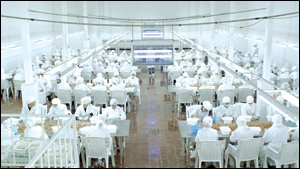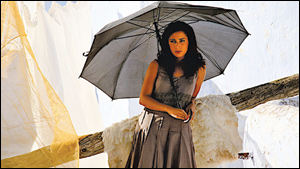By MARTIN DALE

‘On the Edge’

A new generation of filmmakers emerge with pics like Narjiss Nejjar’s ‘The Rif Lover.’
In the wake of the Arab Spring, the spotlight is turning to Arab films. Morocco is well placed to shine: It stands at the forefront of democratic reforms and has one of the region’s strongest national film support systems.
“We’re seeing something quite new in Moroccan cinema,” says Faical Laraichi, head of pubcaster SNRT, which has played a key role in nurturing local talent. “Until a few years ago the dominant style was social realism, but now we’re seeing tremendous diversity, including avant-garde styles, comedies, action-adventure, many new directors and new genres.”
“Industries such as Bollywood revolve around formula pics,” says Noureddine Sail, head of the Moroccan Cinema Center. “In Morocco, we have a very eclectic, creative approach.”
Sail cites the six films playing Marrakech, which include film noir, baroque excess, Italian-style comedy and neo-realism.
Riding this energy wave, Moroccan films have increased their presence at Cannes, Toronto and Abu Dhabi over the past 12 months.
The French-Morocco axis is also building as Paris-based co-producers and sales agents channel funds and production expertise to Moroccan films and cherry-pick young helmers.
“This is an exciting period for Moroccan cinema,” says director Leila Kilani. “You can feel the sense of expectation at big festivals. There’s a new generation of Moroccan filmmakers coming onto the scene.”
Kilani’s debut feature, “On the Edge,” about four girls from Tangiers who peel shrimps by day and turn tricks by night, is a perfect example. Kilani produced her €1.2 million ($1.64 million) pic through her Moroccan shingle, Socco Chico, with France’s Aurora Films. Fortissimo handles international sales. Following the pic’s Cannes world premiere, and after kudos from San Sebastian, Abu Dhabi and Taormina, Kilani describes her Moroccan premiere at Marrakech as the “most exciting and yet scariest” of her screenings to date.
Morocco boasts an increasing number of successful local producers. Producer-director Nabil Ayouch has one of the strongest track records, including an impressive series of 42 TV movies, produced for SNRT. He is filming the $4.8 million “The Stars of Sidi Moumen,” about the teenage suicide bombers involved in the 2003 Casablanca bombing, co-produced by Pierre-Ange Le Pogam’s Stone Angel.
Upcoming young producers include Lamia Chraibi, named one of Variety Arabia’s Five Arab Producers to Watch at October’s Abu Dhabi Festival.
Chraibi’s recent credits include Marrakech’s opener, Narjiss Nejjar’s “The Rif Lover,” about a 20-year-old woman jailed for being a drug baron’s lover; Mohamed Achour’s quirky comedy about filmmaking, “The Film”; and Hicham Lasri’s moody B&W sophomore pic, “The End,” set against the birth of a liberal era under King Mohammed VI. Latter is sold by Insomnia World Sales.
One of Morocco’s main challenges is lack of screens. They have halved since 2004, causing total national admissions to drop from 6.8 million to 2.5 million in this period. At present 63% of the country’s box office is generated by only two multiplexes — in Casablanca and Marrakech — both owned by Megarama.
The French chain has inked deals with the CCM to build five multiplexes over the next two years — a 10-screener in Rabat, 12-screener in Agadir, 10- and eight-screeners in Tangiers and a five-screener in Fez.
Within five years, all Moroccan screens will be digital; ticketing systems will be computerized and centralized by January.
U.S. movies take a 52% market share, performing particularly well in the multiplexes. Moroccan films also command a loyal following, with around a 20% share every year.
The most popular local titles over the past 12 months — both expected to generate over 100,000 admissions by December — have been Mohamed Karrat’s musical comedy “Nhar tzad tfa dow” (“When I Was Born There Was a Power Cut”), starring local beau Rachid El Ouali, and Abdelhai Laraki’s romantic tale “Love in the Medina” starring young heartthrob Omar Lotfi.
But there has been no local blockbuster in 2011.
Helmer Noureddine Lakhmari, who directed the hit “Casanegra” in 2009, with 240,000 admissions, is hoping to generate an equally strong reaction with his upcoming “Zero” about an antihero seeking redemption, that he hopes to have ready in January.
“We need an event film every three months,” says Lakhmari. “I have great hope for the future. Culture stands at the heart of change in Morocco.”
Filmmakers welcome the reforms passed in Morocco in 2011, but helmers such as Lakhmari and Ayouch nonetheless express concern about the outcome of the Nov. 25 parliamentary elections, in which they fear conservative forces may gain leverage.
“It’s like being on a train,” Ayouch says. “We don’t know where it will stop or ultimately where it’s going.”
Young helmer Adil el Fadili (“A Short Life”) is nonetheless upbeat. “It’s too late for extremism. We’ve tasted freedom and there’s no going back,” he says.
Sail concurs, “I find it difficult to take seriously a country that doesn’t have a vibrant national film industry, because it shows it has a problem with freedom of expression, which ultimately means it has a problem with freedom itself.”






